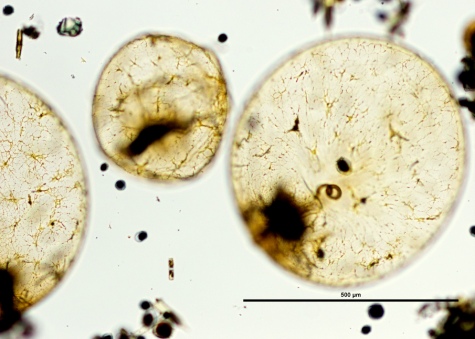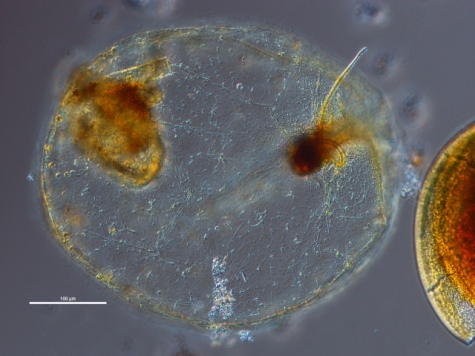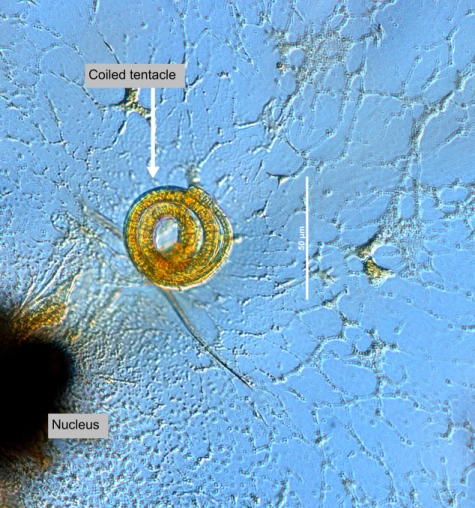



|
Synonym(s)
Medusa scintillans Macartney 1810
Noctiluca miliaris Suriray 1816
Mammaria scintillans Ehrenberg 1834
Noctiluca marina Ehrenberg 1834
(Kraberg et al. 2010)
Classification
(Guiry and Guiry 2012)
Lifestyle
Isogamy
The simplest type of sexual reproduction between gametes that are similar in size and shape. Instead of being classified as male and female cells, organisms of different mating types (i.e., different size and shape of gamete) can fuse to form a zygote (Botany Dictionary 2002).
isogametes and asexually through CloseBinary fission
A form of asexual reproduction where one cell divides into two identical cells. All prokaryotes and some eukaryotes reproduce in this manner. Compare with mitosis, where the nucleus must also divide, adding an extra step to the process.
binary fission (Kraberg et al. 2010).Description
Epicone
In naked dinoflagellates, the anterior part of a dinokont cell above the cingulum. The equivalent of an epitheca for thecate dinoflagellates.
epicone and CloseHypocone
In naked dinoflagellates, the posterior part of a dinokont cell above the cingulum. The equivalent of a hypotheca for thecate dinoflagellates.
hypocone are not differentiated (Kraberg et al. 2010). It has only one transverse flagellum and one striated tentacle (Horner 2002). It does not ClosePhotosynthesis
The chemical process by which light energy, water and carbon dioxide are combined to produce oxygen and organic compounds. Photoautotrophic organisms (plants and algae) use this reaction to produce their own food.
photosynthesize, so it does not have chloroplasts. It has a phagotrophic food CloseVacuole
A membrane-bound organelle found in some protists, containing a water solution of organic and inorganic molecules (including enzymes). In some cases, vacuoles may contain engulfed solids (Falkowski et al. 2004).
vacuole that often contains prey organisms, such as diatoms and ciliates (Horner 2002). The vegetative cells are CloseDiscoid
Disc-shaped.
diploid with gymnodinioid CloseGamete
A reproductive cell (sperm or ovum) that can combine with another reproductive cell to create a new individual.
gametes (Horner 2002, Kraberg et al. 2010).Measurements
Similar species
Harmful effects
Harmful Algae Bloom
(HAB) The rapid growth and/or accumulation of algae in areas of constricted flow which may be harmful to the environment, animals, plants or humans by depleting oxygen, obstructing sunlight, and (in some cases) releasing toxins (Heisler et al. 2008).
(HAB) because of its ability to produce toxic concentrations of ammonium, deplete oxygen levels in the water and clog other organisms' gills (Escalera et al. 2007).Habitat
Distribution
It is distributed worldwide in cold to warm coastal waters (Horner 2002).
Large blooms are commonly seen from spring to early summer in Helgoland off northern Germany (Smithsonian 2012). A small peak abundance was also observed in Helgoland from December to January (Uhlig and Sahling 1990).
Growth conditions
Environmental Ranges
Temperature range (°C): 8.413 - 24.625
Nitrate (μmol L-1): 0.044 - 8.908
Salinity: 17.095 - 35.840
Oxygen (mL L-1): 0.516 - 6.874
Phosphate (μmol L-1): 0.128 - 1.682
Close
Silicic acid
A general term to describe chemical compounds containing silicon, oxygen and hydrogen with a general formula of [SiOx(OH)4-2x]n. Diatoms polymerize silicic acid into biogenic silica to form their frustules (Azam and Chisholm 1976).
Silicate (μmol L-1): 0.648 - 77.938(EOL 2012)
Bloom characteristics
References
Encylopedia of Life (EOL). 2012. Noctiluca scintillans (Macartney) Kofoid and Swezy 1921. http://eol.org/pages/901153/details. Accessed 29 Feb 2012.
Escalera, L., Pazos, Y., Moroño, A. and Reguera, B. 2007. Noctiluca scintillans may act as a vector of toxigenic microalgae. Harmful Algae. 6(3): 317-320.
Guiry, M. D. and Guiry, G. M. 2012. Noctiluca scintillans (Macartney) Kofoid and Swezy 1921. http://www.algaebase.org/search/species/detail/?species_id=55371. Accessed 29 Feb 2012.
Horner, R. A. 2002. A Taxonomic Guide To Some Common Phytoplankton. Biopress Limited, Dorset Press, Dorchester, UK. 200.
Kraberg, A., Baumann, M. and Durselen, C. D. 2010. Coastal Phytoplankton Photo Guide for Northern European Seas. Verlag Dr. Friedrich Pfeil, Munchen, Germany. 203.
Smithsonian Institution. 2012. Noctiluca scintillans (Macartney) Kofoid and Swezy 1921. http://botany.si.edu/references/dinoflag/Taxa/Nscintillans.htm. Accessed 29 Feb 2012.
Uhlig, G. and Sahling, G. 1990. Long-term studies on Noctiluca scintillans in the German Bight population dynamics and red tide phenomena 1968-1988. Netherlands Journal of Sea Research. 25(1-2): 101-112.
